- AI Fire
- Posts
- 🤖 My AI Writing Sounded Like A Robot. Here's How I Fixed It
🤖 My AI Writing Sounded Like A Robot. Here's How I Fixed It
Your articles sound too perfect... too robotic. Before you publish, check for these 5 dead giveaways of AI writing and learn how to erase them for good.
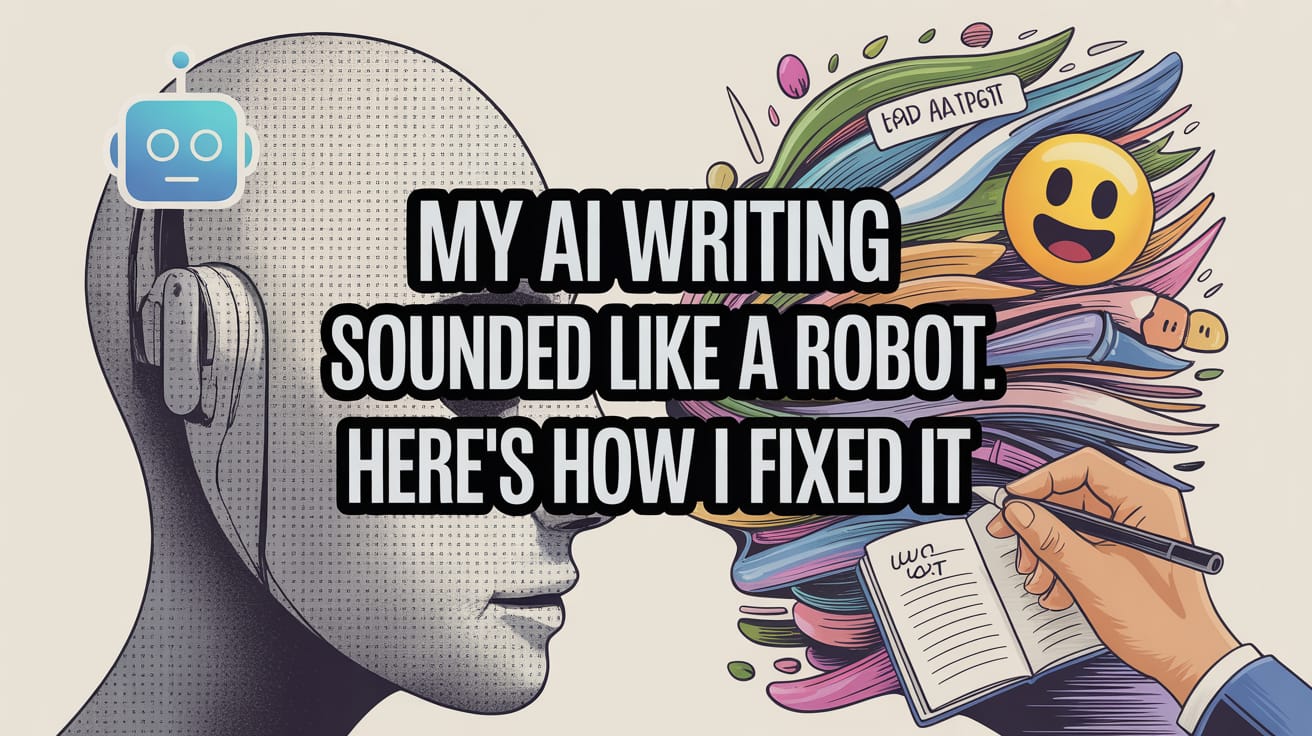
📊 Quick Poll: How much do you edit your AI-generated text? |
Table of Contents
I remember the first time I used an AI tool like ChatGPT. It felt like magic. You type a few ideas, and boom, a full article appears. The outline, the words, the grammar - everything was correct. I thought, "Wow, this is the shortcut to creating content 10 times faster!"
I started using it for everything: writing for my personal blog, creating emails for clients, and even thinking of captions for social media. At first, I was very happy. I was working so much faster. But after writing dozens of articles, I started to notice a worrying problem.

When I read my articles again, they didn't sound like me anymore. They sounded very… robotic.
It’s not that the writing was bad. Actually, it was very good. The sentences were neat, and the words sounded professional. But this "too perfect" style made the writing lose its soul. It didn't have the messy sentences, the random thoughts, or the silly jokes - the things that make a writer feel like a real person. My writing became boring, empty, and worst of all, it looked exactly like thousands of other articles also created by AI.
And that is a very serious problem.

Today, an article that sounds like AI is worse than a badly written article. A bad article at least has a personality and shows that a human tried. But a lazy article made by AI just shows that you don't care and you're not being honest. Readers are smart. They don't just read for information; they want to connect with the writer. If they feel like a machine is talking to them, they will leave immediately.
Many articles online with titles like "how to spot AI content" often give very general advice that isn't very helpful. They don't really help writers like us.
So, in this article, I won't say the same old boring things. This article is for thoughtful writers - people who want to use the power of AI to work better, not to let AI replace their voice and their thinking.
After writing and editing hundreds of articles with help from AI, I realized the most important work is not the "prompting" (giving commands). It's everything else around it: brainstorming ideas, building an outline, and especially, editing.
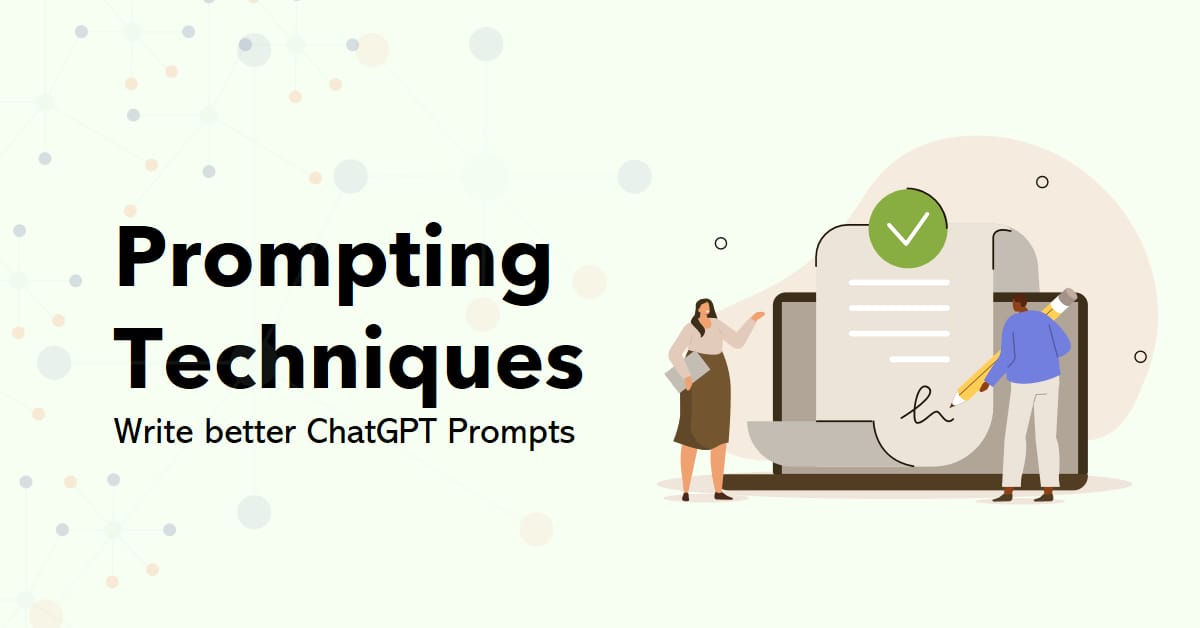
This article will focus on editing. I will share the 5 clearest "robot" signs that AI often creates, and how I remove them to turn a dry article into a piece of writing that has feeling and a personal touch.
Think of this as not just a way to fix AI writing, but also as a guide to check your own writing. This is because these signs are really just signs of weak, lazy writing that AI has made more common.
Why Does AI Often Write In A Repetitive Way?
Before we start, we need to understand a little about how AI creates text. Imagine AI is like a student who has read every book, newspaper, and blog in the world. It has a huge memory of the most common sentences, structures, and phrases.
When you ask it to write about a topic, it doesn't "think" or "create" like a person. Instead, it does something simpler: it predicts the next word. Based on billions of examples it has learned, it will choose the word that is most likely to come next after a series of words.
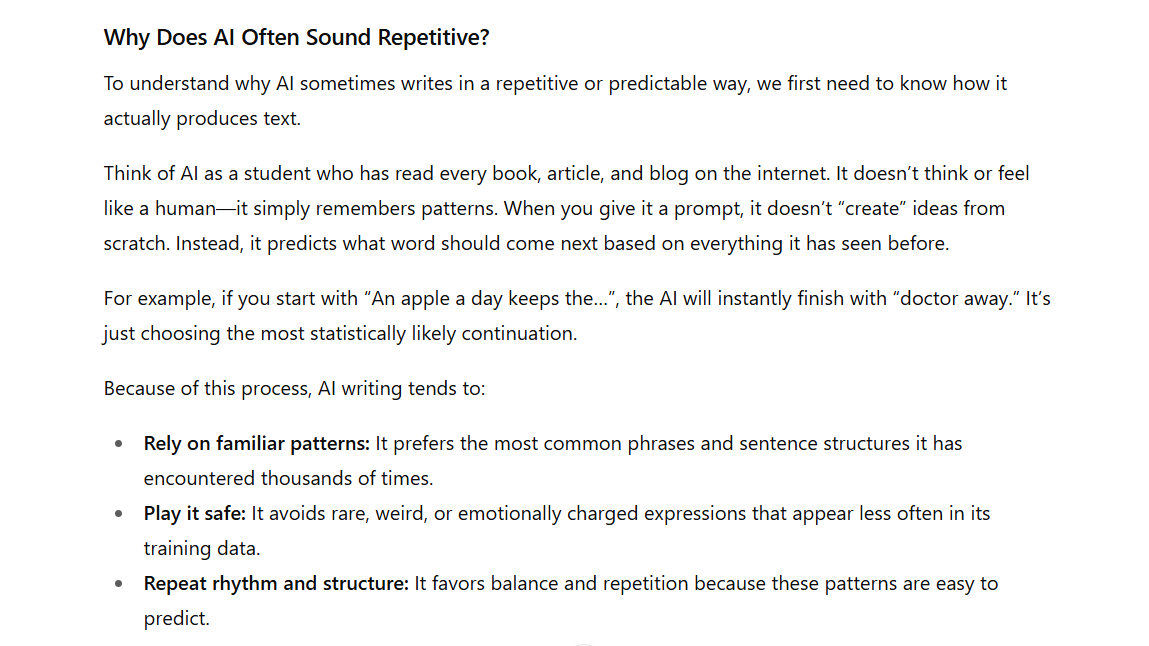
For example, if the sentence is "An apple a day keeps the...", the AI will almost certainly fill in the word "doctor away."
Because of how it works, AI tends to:
Use common patterns: It uses the most popular structures and phrases because it has seen them the most in its data.
Be safe and neutral: It avoids unique, strange, or controversial phrases because they are less common.
Repeat patterns: It loves balanced, rhythmic structures because they are easy to recognize and repeat.
The result is writing that sounds very "smooth" but has no surprises or emotion. Our job as writers is to step in, break these safe patterns, and bring the text to life.
Now, let's look at the 5 specific signs.
Learn How to Make AI Work For You!
Transform your AI skills with the AI Fire Academy Premium Plan - FREE for 14 days! Gain instant access to 500+ AI workflows, advanced tutorials, exclusive case studies and unbeatable discounts. No risks, cancel anytime.
5 Signs To Remove So Your Writing Doesn't "Smell Like AI"
These are the exact patterns I found in my own drafts, again and again, until I learned to name them and get rid of them. Once you see them, you will notice them everywhere.
1. The Three-Part Rhythm Trap (Too Short And Repetitive)
AI absolutely loves the rhythm of three. You will see it everywhere: short slogans, and pieces of advice broken into three parts.
Using it once or twice is okay. It can make your point sound strong and clear. But when you use it too much, your whole article sounds like a pre-programmed speech. It’s very boring and unnatural. AI does this because the "rule of three" is a very common tool in human communication, and the AI just copies and exaggerates it.
Common examples:
Commands: Three short commands in a row.

AI's version:
"Start now. Work hard. Never stop."
Descriptions: Three short adjectives listed together.

AI's version:
"It's fast, simple, and powerful."
Statements: Three short, punchy sentences with equal importance.

AI's version:
"You tried. You failed. You learned."
What's the problem? Too much rhythm becomes robotic and boring. The reader can no longer hear your voice; they only hear a machine counting beats. It removes detail, flattens emotion, and makes your writing sound the same as millions of other AI-generated articles.
How I fix it:
I intentionally break the rhythm. Instead of three short sentences, I will write one very short sentence, followed by a very long and detailed sentence, and then end with a medium-length sentence. Changing the sentence length creates a natural rhythm, like a person breathing while they talk.
AI's draft:
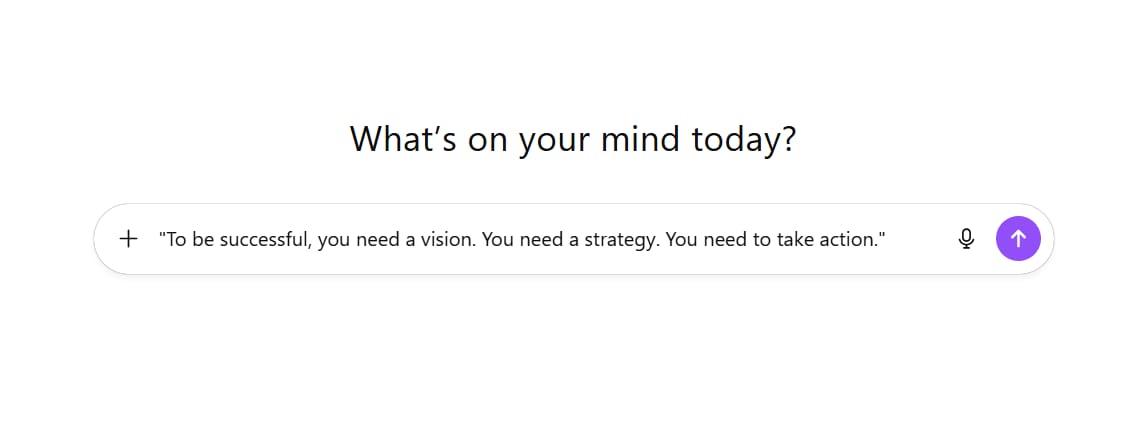
"To be successful, you need a vision. You need a strategy. You need to take action."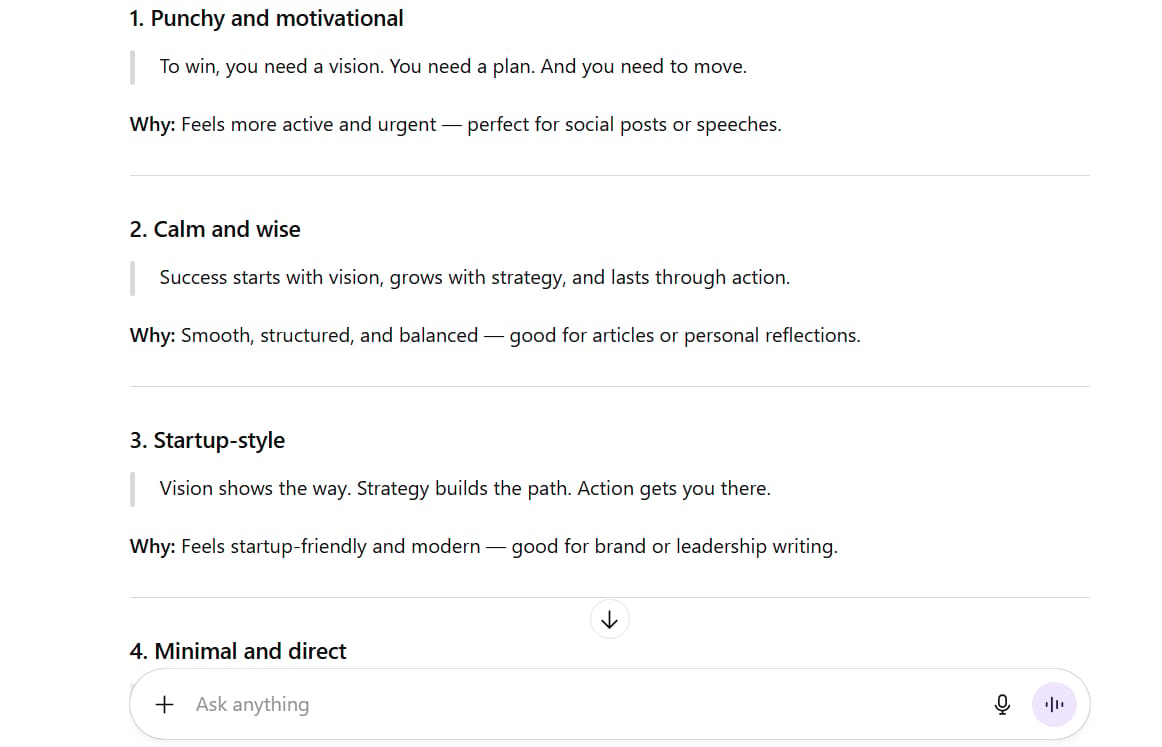
How I rewrite it:

"Many people think a vision is the most important thing for success. But in my opinion, a vision without a clear, step-by-step strategy is just an empty dream. And in the end, all those plans will just stay on paper if you don't start taking action, even with the smallest steps."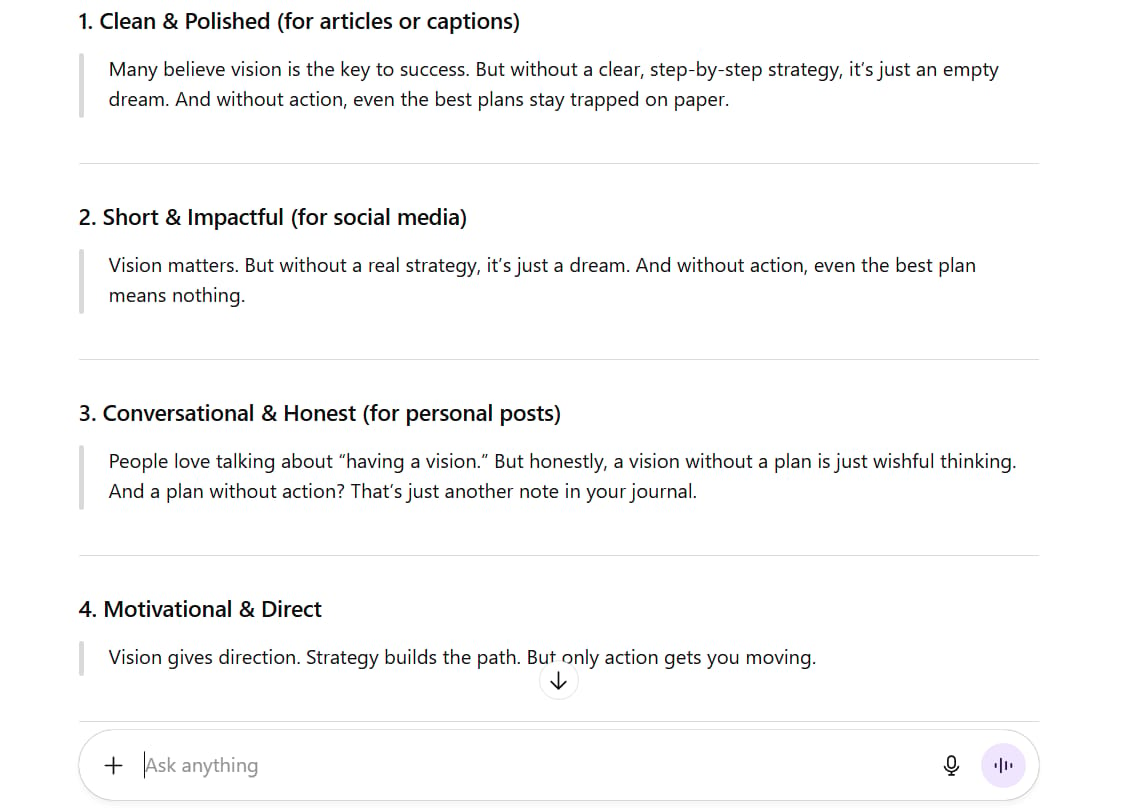
See? It's no longer a series of short punches. It's a line of thought that has depth and connection between the ideas.
Most importantly, write how you think. This is a better version of the classic advice "write like you talk." Because sometimes, maybe you're like me, and you're not a great talker. But your way of thinking is always unique. Let the messiness, the pauses, and the discoveries in your thoughts show up on the page.
A prompt you can use to avoid this mistake:
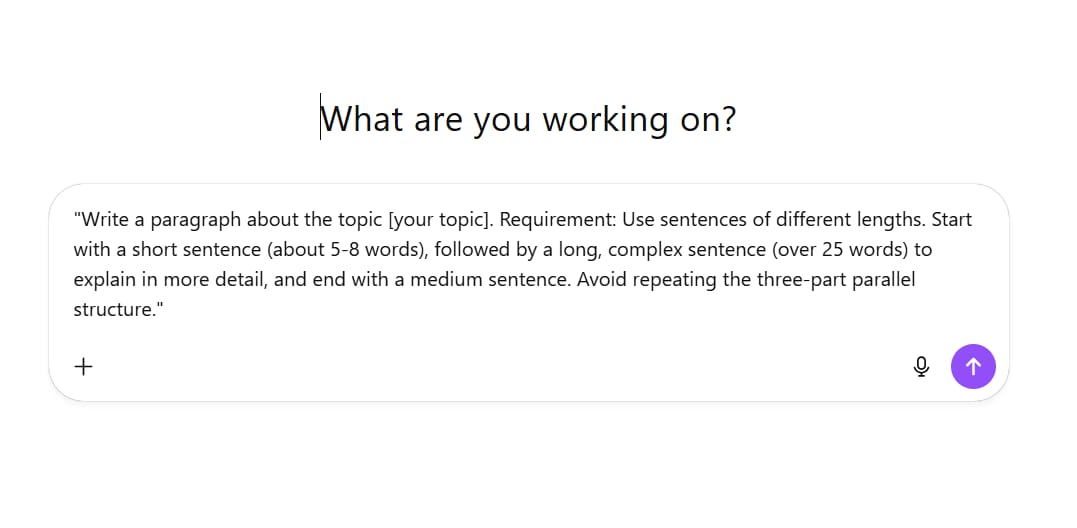
"Write a paragraph about the topic [your topic]. Requirement: Use sentences of different lengths. Start with a short sentence (about 5-8 words), followed by a long, complex sentence (over 25 words) to explain in more detail, and end with a medium sentence. Avoid repeating the three-part parallel structure."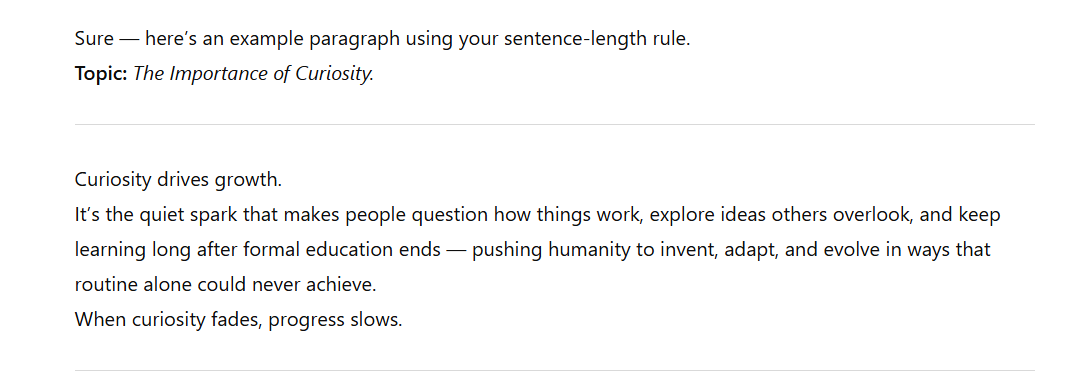
2. Overusing Parallel Structures ("Not This, But That")
AI loves the comfort of clear, opposite ideas.
You have definitely seen this type of sentence before: "It's not about working hard, it's about working smart." Or “This is not just a product, it’s a solution.”
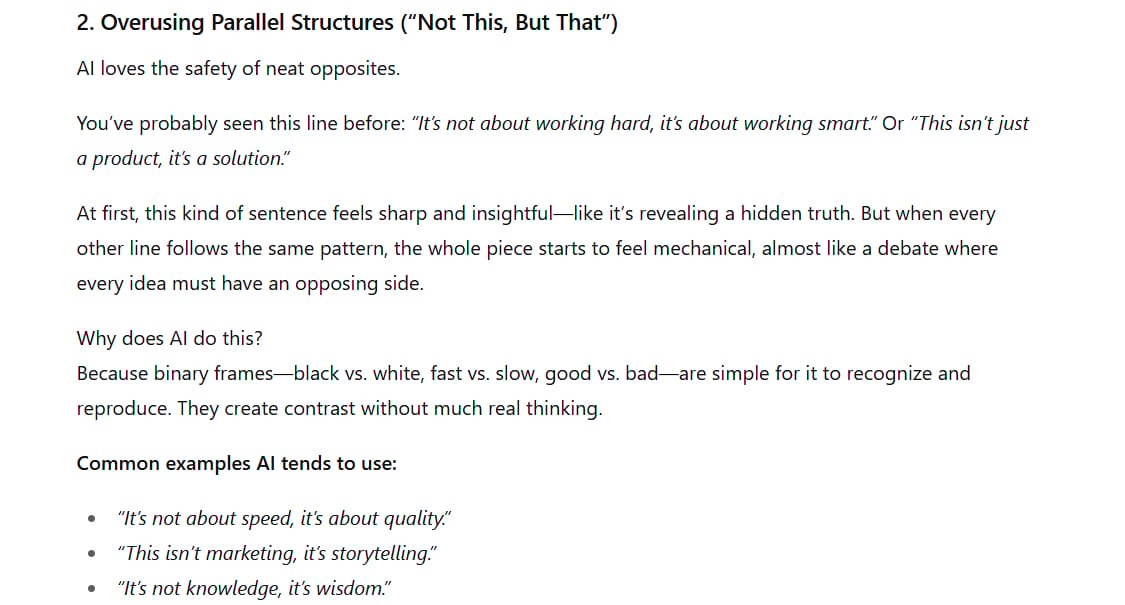
The first time you read it, it sounds very clever, as if it just revealed a great truth. But if you use this structure too many times, the entire article becomes an unnecessary fight, where everything is either black or white.
AI does this because binary frames (black/white, good/bad) are easy for it to process and create strong contrast.
Common examples:
Binary values: "It's not about speed, it's about quality."
Redefining purpose: "This isn't marketing, this is storytelling."
Creating fake depth: "It's not knowledge, it's wisdom."
What's the problem? Too many parallel structures make the thinking feel flat. Real life and human thoughts are not always so clear. We live with contradictions and in shades of gray. Real writing is a place to show these complex ideas. That’s what makes it human.
How I fix it:
I will only keep one "not this, but that" sentence if it is truly powerful and makes a big impact. I cut the rest. Instead of creating opposites, I try to show the complexity.
AI's draft:

"Leadership is not about giving orders. It is about inspiring people. It is not about power. It is about responsibility."How I rewrite it:
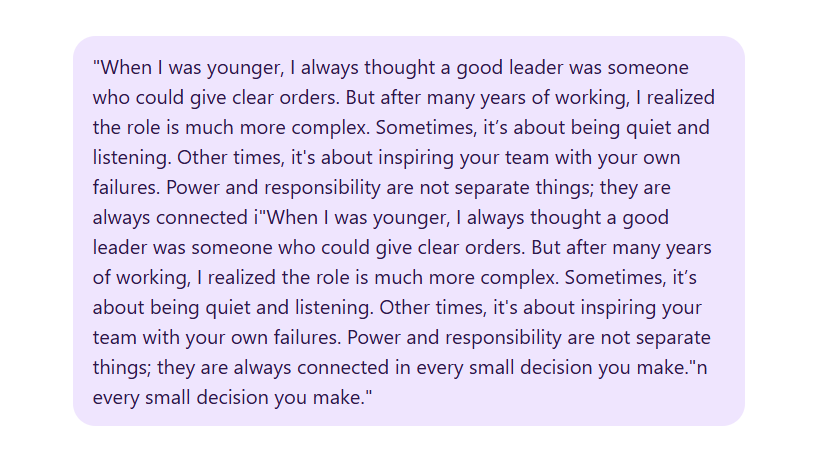
"When I was younger, I always thought a good leader was someone who could give clear orders. But after many years of working, I realized the role is much more complex. Sometimes, it’s about being quiet and listening. Other times, it's about inspiring your team with your own failures. Power and responsibility are not separate things; they are always connected in every small decision you make."The rewritten version doesn't try to make things simple. It accepts the complexity and shares a more personal view. It doesn't solve the question neatly, but it sounds like a real person trying to understand something.
A prompt you can use to avoid this mistake:
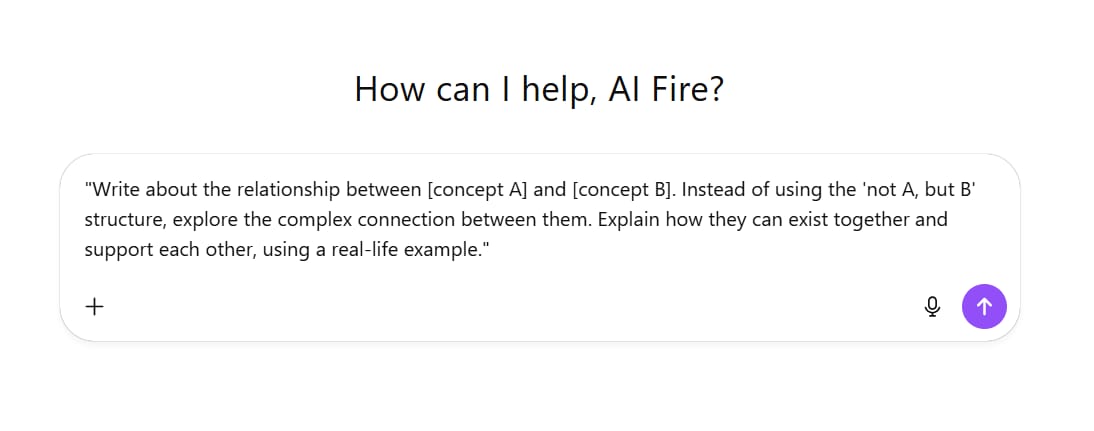
"Write about the relationship between [concept A] and [concept B]. Instead of using the 'not A, but B' structure, explore the complex connection between them. Explain how they can exist together and support each other, using a real-life example."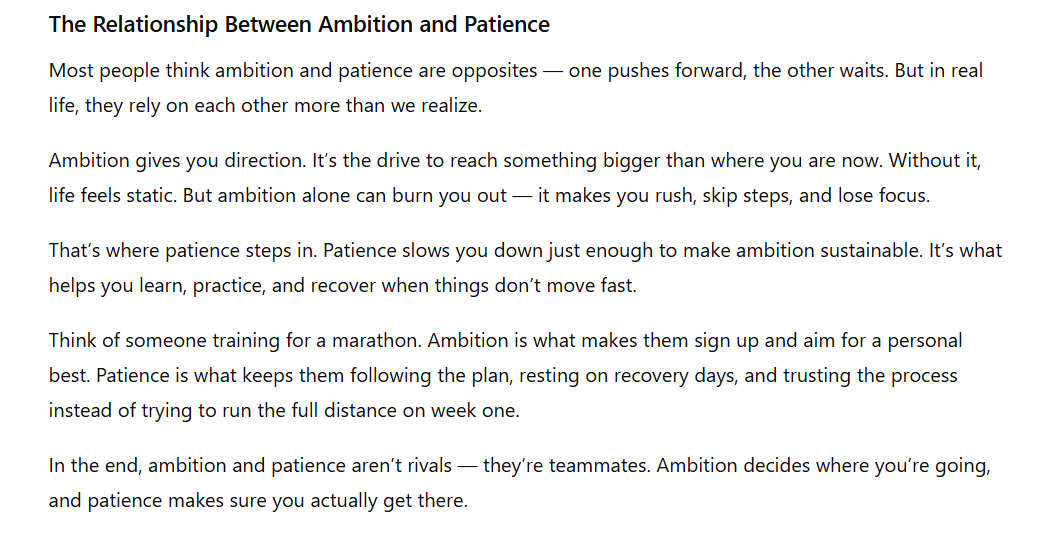
3. Using Too Many "Big Reveal" Tricks (Fake Questions And Answers)
AI often uses a question-and-answer rhythm by default. It feels like a conversation, but it's not.
Using it once can be effective. But if you repeat it, your writing will sound like a checklist of boring answers. This Q&A style is very safe. It pretends to create connection with the reader without needing any real personality.
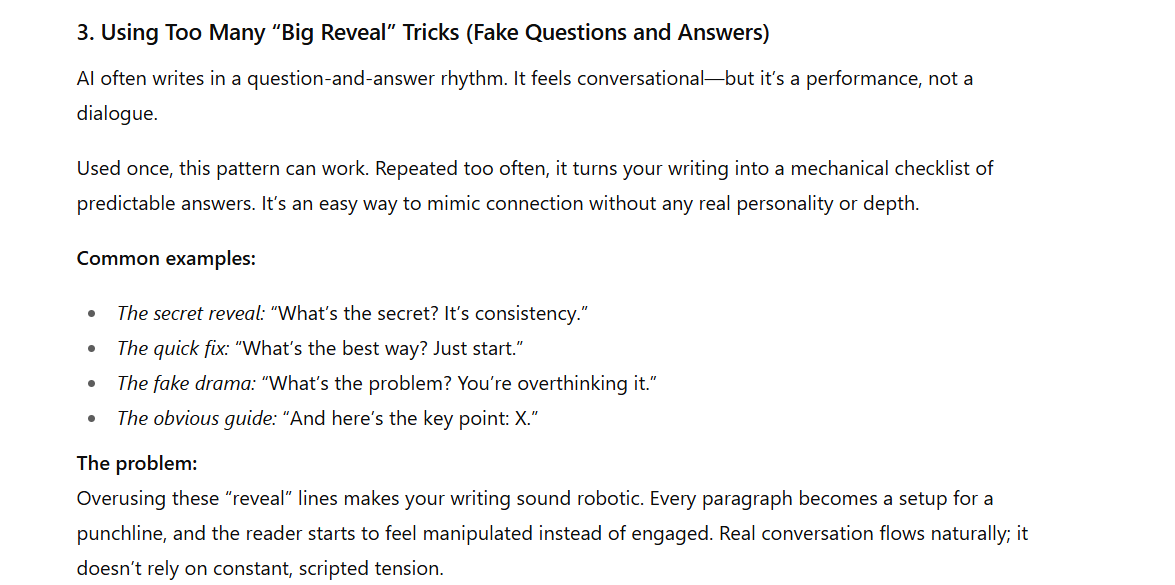
Common examples:
The secret reveal: "What's the secret? It's consistency."
The quick fix: "What's the best way? Just start."
The fake drama: "What's the problem? You're overthinking it."
The obvious guide: "And here's the key point: X"
What's the problem? When you use this too much, the writing loses all personality. Every line becomes a trick. The reader feels like they are being awkwardly led through a pre-written script, instead of following a natural flow of thoughts.
How I fix it:
I get rid of most of this "script." Instead of asking a question and answering it right away, I tell a story. Instead of offering a "secret," I share a personal experience, a metaphor, or even a confession. One specific idea or a powerful moment from your life is stronger than ten fake Q&A sets.
AI's draft:

"How do you overcome procrastination? The answer is simple. You just need to break down your tasks."How I rewrite it:
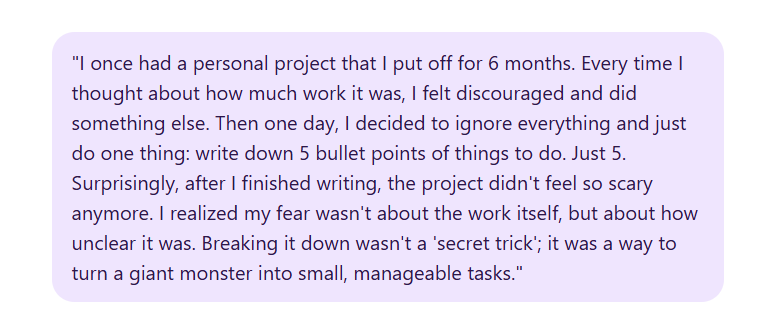
"I once had a personal project that I put off for 6 months. Every time I thought about how much work it was, I felt discouraged and did something else. Then one day, I decided to ignore everything and just do one thing: write down 5 bullet points of things to do. Just 5. Surprisingly, after I finished writing, the project didn't feel so scary anymore. I realized my fear wasn't about the work itself, but about how unclear it was. Breaking it down wasn't a 'secret trick'; it was a way to turn a giant monster into small, manageable tasks."This personal story gives the same message ("break down your tasks") but in a way that is much more convincing and memorable.
A prompt you can use to avoid this mistake:
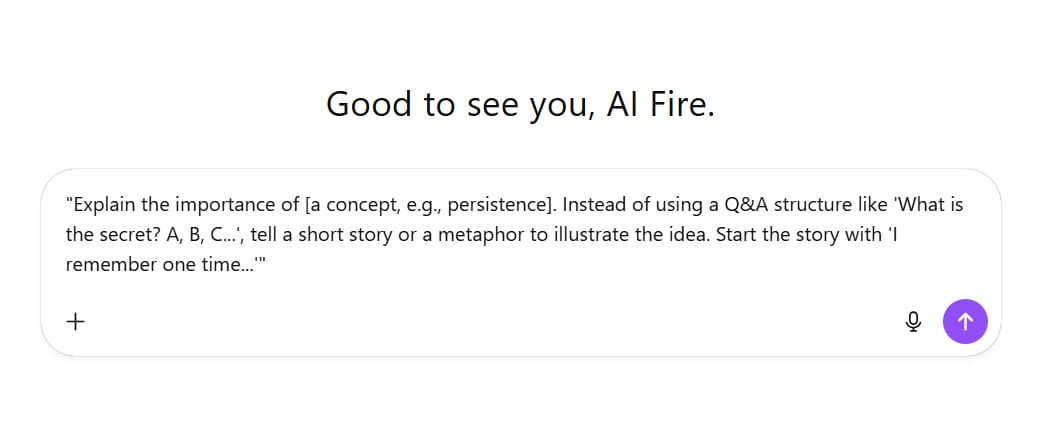
"Explain the importance of [a concept, e.g., persistence]. Instead of using a Q&A structure like 'What is the secret? A, B, C...', tell a short story or a metaphor to illustrate the idea. Start the story with 'I remember one time...'"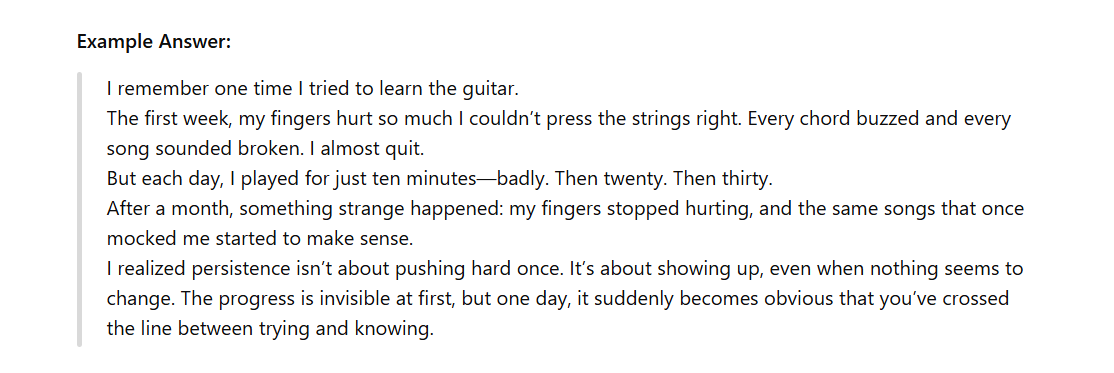
4. Weird Emphasis Or Fake Details
AI loves to focus on the wrong detail and make it seem important. Why? Because being specific looks like authority. AI thinks that if it sounds precise, it will sound persuasive.
Common examples:
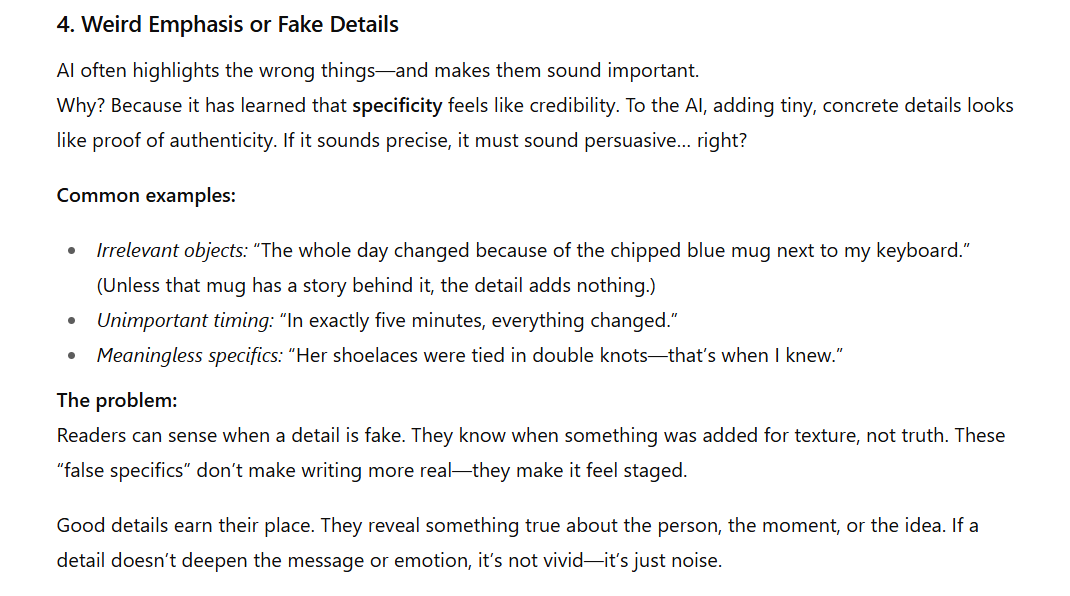
Irrelevant objects: "The whole day changed because of the chipped blue mug next to my keyboard." (Unless the mug has a special story, this detail is meaningless).
Unimportant timing: "In exactly five minutes, everything changed."
Meaningless details: "Her shoelaces were tied in double knots - that's when I knew."
What's the problem? Readers can feel that it's fake. They know when a detail is just filler, not real substance. These details don't create a connection; they just create confusion and weaken the main message.
How I fix it:
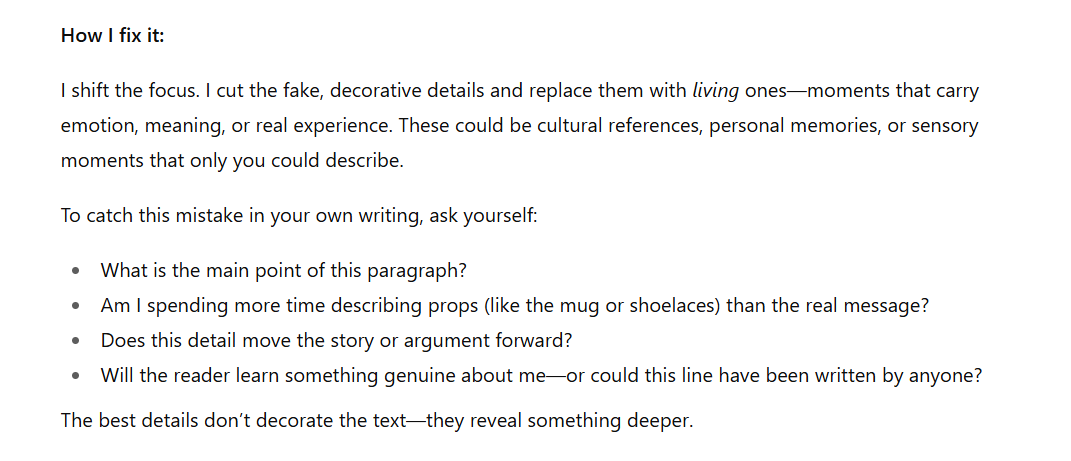
I change the focus. I cut the fake details and replace them with "living" details that actually matter - cultural references, emotional moments, or specific experiences that only you have.
To find this mistake in your own writing, ask yourself these questions:
What is the main point of this paragraph?
Am I using more words to describe props (like the mug or shoelaces) than the main point?
Does this detail actually move the story or argument forward?
Will the reader learn something about me or my perspective from this detail, or could it come from anyone?
If the answer is mostly "no," then it's filler. Cut it.
AI's draft:

"When the rejection email arrived at 3:47 PM, I knew my career path needed to change. The afternoon sun shone through the window, lighting up the dust floating in the air."How I rewrite it:

"When I got the rejection email from my dream job, my first feeling wasn't sadness, but a strange sense of relief. I realized I had been trying to force myself into a box that didn't fit, just because I thought it was the 'right' path. That email wasn't a closed door; it was permission to find a different path that was truly my own."In the rewritten version, the focus changes from the time and the dust (meaningless details) to the internal feeling (a strange sense of relief) - a much more valuable and human detail.
A prompt you can use to avoid this mistake:
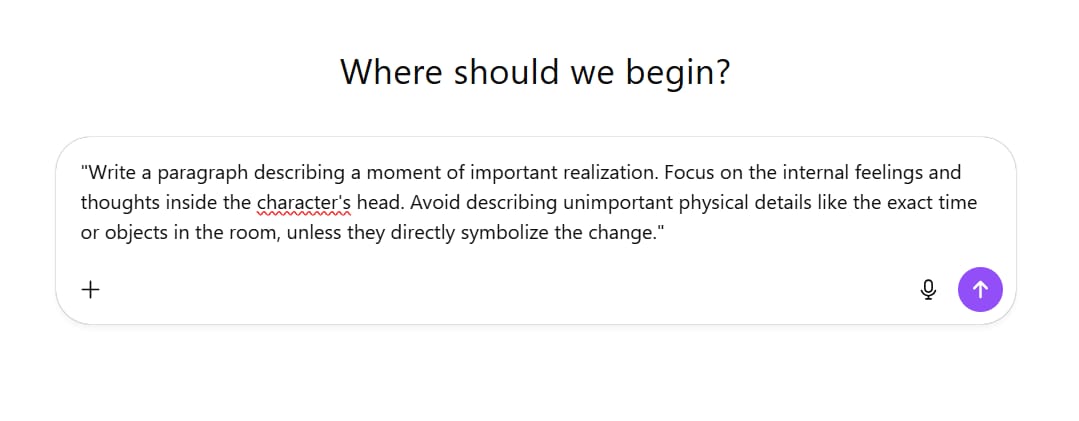
"Write a paragraph describing a moment of important realization. Focus on the internal feelings and thoughts inside the character's head. Avoid describing unimportant physical details like the exact time or objects in the room, unless they directly symbolize the change."
5. The Missing Personal "Fingerprints"
This is the most deadly sign: words with no fingerprints. They are factually correct, but too clean. There is no person behind them.
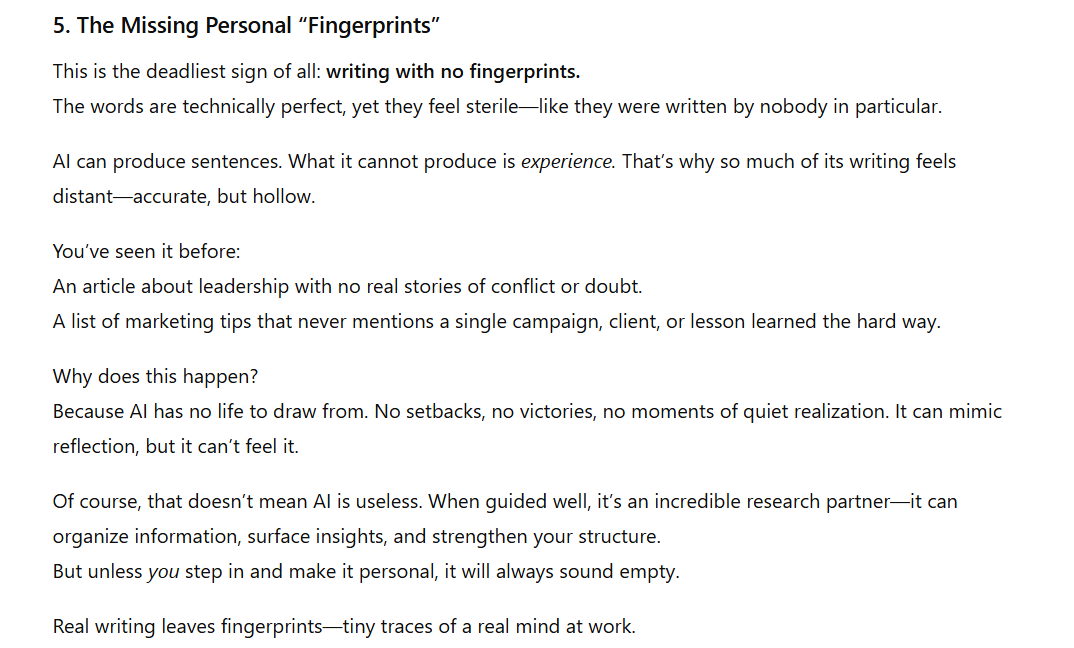
AI can create sentences. It cannot create lived experiences. So, much of its output feels distant, as if it could have been written by anyone at all.
You've seen it: an article full of general advice about leadership, but with no real stories from difficult situations. A list of marketing tips, but with no mention of clients, campaigns, or company culture.
Why? Because AI has no life story to share. It has no failures, no joys, no funny or sad memories.
Of course, it's not all bad. When guided correctly, AI can find information and research to make a draft stronger. But I believe that unless you make it personal, it will always sound empty.
Common examples:
General advice: "Always put the customer first."
Empty slogans: "Content is king."
Vague theories: "Leaders should inspire with a vision."
What's the problem? Without personal or cultural context, content just becomes more noise online. There is nothing for the reader to connect with.
How I fix it:
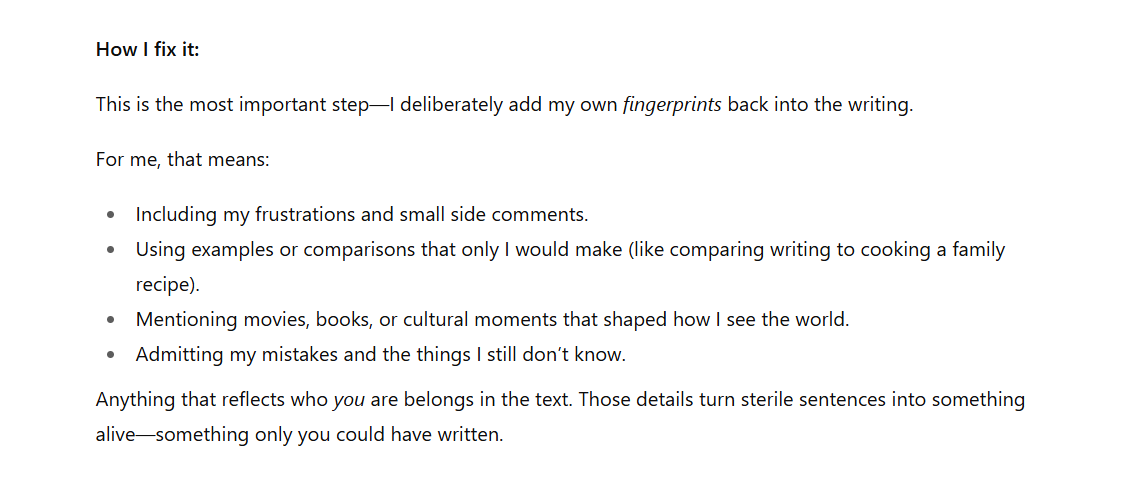
This is the most important part. I intentionally add my "fingerprints" to the writing.
For me, this means:
Adding my frustrations and side comments.
Using examples or comparisons that only I would think of (for example, comparing writing to cooking a family recipe).
Mentioning movies, books, or cultural experiences that have shaped who I am.
Admitting my mistakes and the things I don't know.
Anything that reflects you as a person, add it in.
AI's draft:

"To communicate effectively, it is important to listen actively. Focus on the speaker and show empathy."How I rewrite it:

"I used to be a terrible listener. In conversations, I was just waiting for my turn to speak. It wasn't until a close friend told me bluntly, 'Talking to you is like talking to a wall.' That really shocked me. From then on, I started to learn how to truly listen—not just with my ears, but trying to feel what the other person wasn't saying. It was much harder than I thought, but it completely changed my relationships."This personal story doesn't just explain "active listening"; it shows the journey of learning it. It makes the reader feel closer to you and trust you more.
A prompt you can use to avoid this mistake:
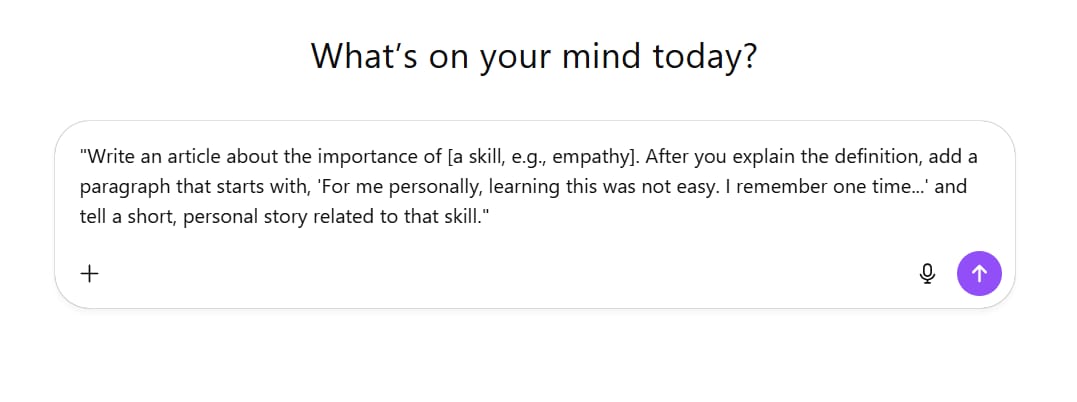
"Write an article about the importance of [a skill, e.g., empathy]. After you explain the definition, add a paragraph that starts with, 'For me personally, learning this was not easy. I remember one time...' and tell a short, personal story related to that skill."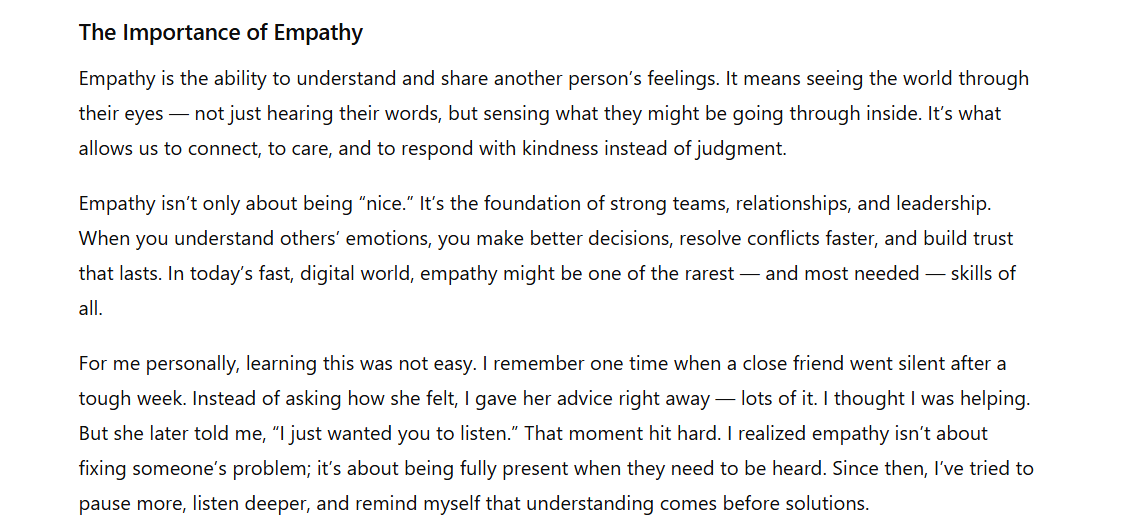
Turning AI From A Crutch Into A Creative Tool
Writing with the help of AI is not cheating. It's a skill. That skill is about shaping its power, using its ability to create instant rough drafts, and then carefully editing until the writing carries your unique fingerprints.

When I remove the 5 signs above, I get an article that is both efficient (thanks to the speed of AI) and deeply human - it has a purpose, a story, and a living voice.
You can absolutely use AI without creating these signs. Editing is one way, but preventing the problem is even better. Learning how to command AI to create drafts that are closer to a human voice from the very beginning is also a powerful skill.
In a world full of algorithms and mass-produced content, your biggest advantage is still the one thing AI can never copy: you. Learn to put yourself into every word you write.
The journey of writing isn't about finding the smartest tools. It's about becoming a wiser editor and a more honest storyteller. AI can help you go faster, but you are the one who decides the direction.
The question isn't whether you should use AI, but how you use it.
You can use it to become another face in the crowd. Or you can use it to become the face that people remember.
The choice - and the opportunity - is yours.
If you are interested in other topics and how AI is transforming different aspects of our lives or even in making money using AI with more detailed, step-by-step guidance, you can find our other articles here:
How useful was this AI tool article for you? 💻Let us know how this article on AI tools helped with your work or learning. Your feedback helps us improve! |
Reply